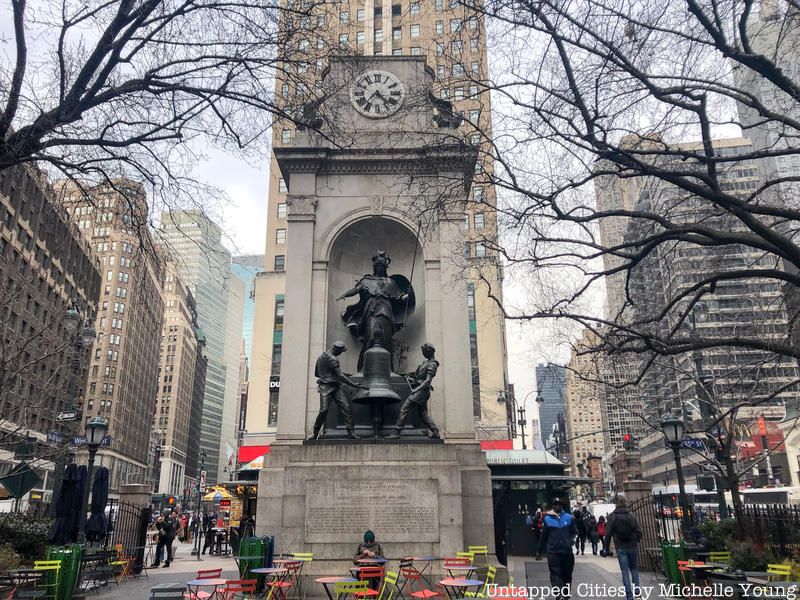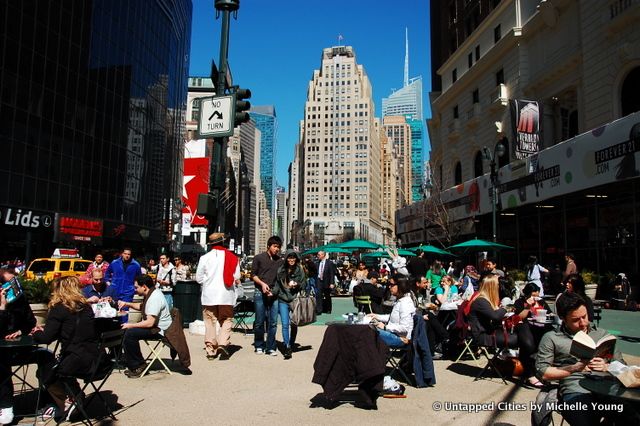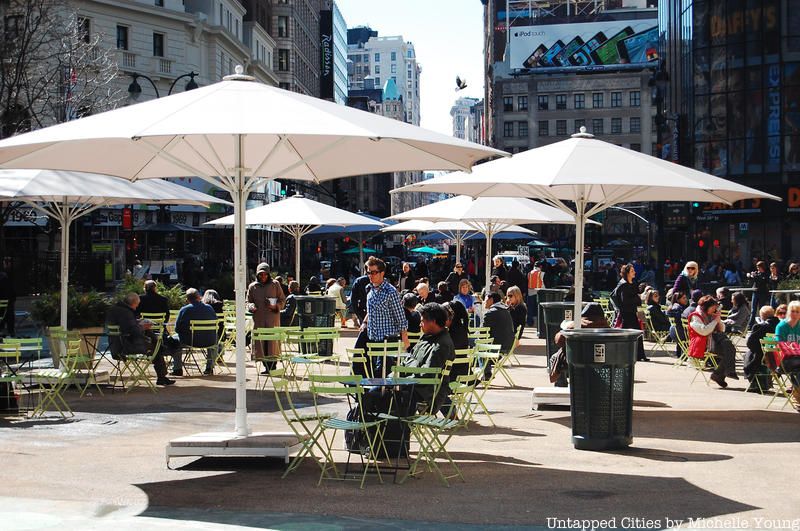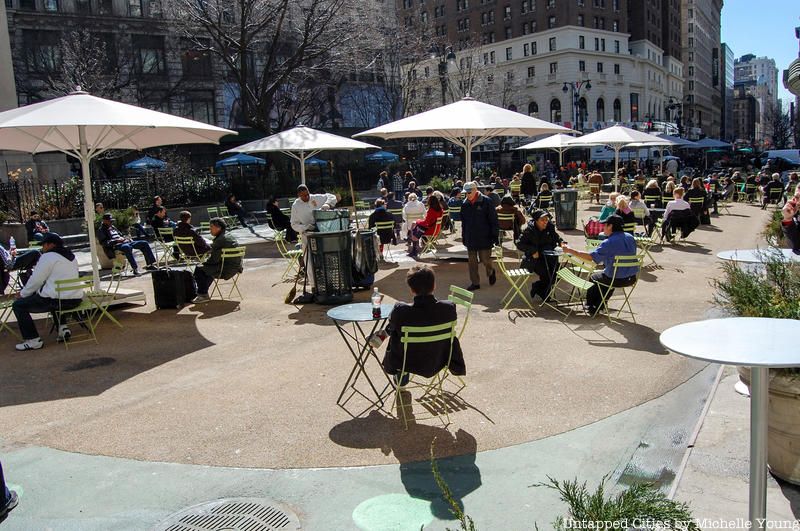Last Chance to Catch NYC's Holiday Notalgia Train
We met the voices of the NYC subway on our nostalgia ride this weekend!


We already covered the secrets of New York City intersections like Times Square and Union Square, both of which are filled with interesting structures and history. Herald Square, formed by the merging of Broadway, Sixth Avenue and 34th street, has some fascinating secrets of its own. From abandoned sky bridges to elaborate statues, here are our top ten secrets of Herald Square.

The New York Herald Building in 1895. Image via Library of Congress.
Just as Times Square was named after the New York Times when it moved its headquarters to the Times Square building, Herald Square actually gets it name from the now defunct newspaper, The New York Herald. James Gordon Bennett Sr. started the paper in 1835, and his son, James Gordon Bennett Jr. took it over in 1866. and moved to Herald Square from Newspaper Row in the 1890s.
This was during an era ripe with sensationalism and newspaper competition, and the New York Herald added to this atmosphere with its coverage of scandal and crime and occasional fabrication.
Bennett asked the famous architect Stanford White to design the exquisite New York Herald Building and signed an ambitious 30-year lease for the area on 35th street between Sixth Avenue and Broadway. based the building off Verona’s Venetian Renaissance Palazzo del Consiglio.
Once Bennett’s lease ended in 1921, the New York Times reported that it would be torn down. It was soon demolished in two stages, in 1928 and 1940. The Herald then relocated to 42nd street.

When the New York Herald’s lease ended, its building’s ornate statues were removed and in 1940, when Herald Square underwent renovation, were given to the city and put on a pedestal in Herald Square.
The centerpiece figure in Herald Square is actually a monument dedicated to James Gordon Bennett Sr. and his son. The monument’s contents are quite interesting; it consists of large clock, a bronze figure of Minerva, the goddess of wisdom and invention, as well as two blacksmiths ringing bells. This sculpture and clock once adorned the top of the Herald building.
Another fun fact: the two blacksmiths are named “Stuff and Guff,” and “Gog and Magog” (their biblical names).
The two, four-foot owls on the monument are also from the original Herald Building (there were originally twenty-six, which were to symbolize the wisdom of the newspaper’s stories). Discover more of NYC’s sculptural owls here.

Like many of the now bustling areas in Manhattan, Herald Square used to be countryside in the early and mid-1800s. But according to the 34th Street Partnership, Herald Square wasn’t just any old farm. This is because Francisco Bastiane, one of the only black men in New York to own land before the abolition of slavery.
In 1846, the city acquired the land to extend Bloomingdale Road, now Broadway. After the subsequent introduction of public transportation, New York City underwent a major transformation into an urban area. The elevated Sixth Avenue train, the second elevated rail in New York City and built in the 1870s, helped transform the 34th street district into a popular area.
The Hilton Passageway once gave access for commuters between Penn Station and the N/R/Q and B/D/F/M trains in Herald Square until the 1970s, when it was closed off due to security reasons. This location is one of the stops on our popular tour of the Remnants of Penn Station, where you can see the contrast of the new and old brickwork. Join our next tour:
Tour of the Remnants of Penn Station

The holdout today, covered in a Macy’s sign
Few probably notice the random five-story building, since a red shopping bag sign covers it. This building was actually a famous “holdout” of a feud from the early 1900s between Macy’s and the competing dry goods store Siegel-Cooper.
Macy’s verbally agreed to buy this land plot on 34th street and Broadway. However, an agent from Siegel-Cooper, Robert H. Smith, bought the building for $375,000 in 1900. Why? Siegel-Cooper wanted Macy’s to give it its 14th street store in return for this 34th street location. However, as you can see today, Macy’s then decided to just build around the small area.
By 1931, the small building was already covered in billboard advertisements. Today, the oversized shopping bag sign is displayed through a lease agreement between the building owners.

The Herald Square Theater in 1907. Image from Library of Congress via Wikimedia Commons
The Herald Square Theater, a Broadway theater, was built in 1883 on the corner of Broadway and 35th street and was called the “New Park Theater.” It was then rebuilt eleven years later as the “Herald Square Theater.” Despite its plain-looking facade, it has quite a few superlatives.
A second interesting tidbit: William Randolph Hearst, publisher of the New York Journal and the infamous promoter of yellow journalism, first saw his wife, chorus girl Millicent Willson, at this theater.
In 1911 it became the first New York City theater to be converted into a silent movie house, but closed in 1914.

The original cast-iron gate of The McAlpin Hotel
Now an apartment building called Herald Towers, the Hotel McAlpin used to be the world’s biggest hotel when it opened. It had 1,500 rooms and a basement restaurant called the Marine Grill with terra cotta ornaments and vaulted ceilings. It also had murals showing New York City’s history. These, along with a cast-iron gate from the hotel, were moved to the Fulton Street station in 2000.

Image via Wikimedia Commons from Library of Congress.
The Macy’s flagship store moved uptown to Herald Square in 1902, leaving Manhattan’s main dry goods district. So the company paid for a steam wagonette to transport customers from 14th street to 34th street.

Though it’s strange to picture an aquarium in Midtown Manhattan, the New York Aquarium was in the same location as the New Park Theater. It was founded by William Cameron Coup and Charles Reiche. According to the Green Book Magazine, it was very successful, as the public was excited about the novelty of the institution. However, the excitement began to wear off and the aquarium began to lose money. Brooklyn vaudeville managers tore it down in 1880 to make it the New Park theater.

On West 32nd street in Herald Square is one of the city’s most impressive skybridges. It is a remnant of Gimbel’s Department Store, which opened in this location in 1910 and competed with Macy’s. Gimbel’s built the green skybridge to connect the store to its next door annex.
Though it was almost destroyed when the owners of the Gimbel’s building changed, it still intact (albeit decrepit and obsolete). You can see its interior here, and learn more about other New York City sky bridges.

The 2009 Broadway Boulevard project conducted by the New York City Department of Transportation aimed to address the issue of vehicular congestion along Broadway and to better meet pedestrian needs in the crowded intersections it formed. Broadway’s position as a diagonal street across Manhattan’s gridlock street pattern meant that it had opportunities for abnormal intersections, but also potential for great public spaces.
One of the biggest changes that occurred was the complete closure of Broadway to vehicle traffic at Herald Square. As a result, there was room for new pedestrian plazas, as well as longer signal times for vehicles along adjacent avenues. There are still more modifications to come.
Next, try the The Top 10 Secrets of Macy’s in Herald Square NYC and Vintage Photos: The Evolution of Times Square from 1898 to Today. Discover more from the book Broadway by Untapped Cities founder Michelle Young.
Subscribe to our newsletter